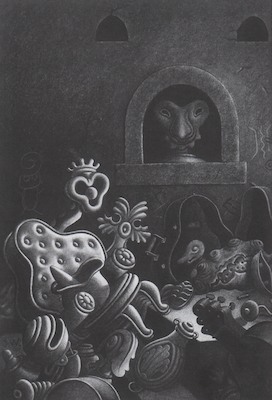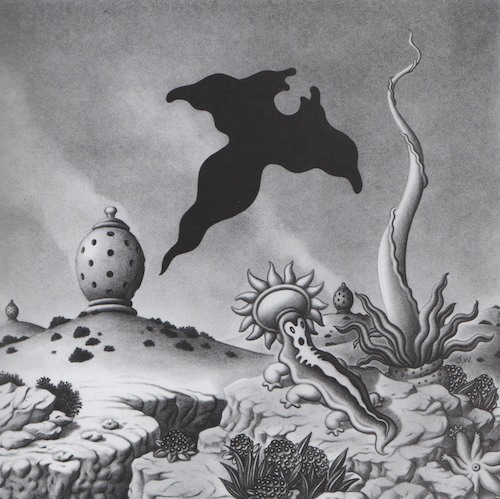Austin Gross
INTRODUCTION: TWO TRUTHS AND A LIE
ISSUE 7 | LIES | AUG 2011

Jim Woodring, The Holy Land, 2005
The most titillating party games are confessional. “Kill/Fuck/Marry” is cynically so—if not shameless, at least ungodfearing. Nobody is punished in that game. Punishment anticipated is rerouted back into a confession of violence. “Truth or Dare?” punishes players for keeping secrets. Its special charm lies in the fact that these punishments always threaten to reveal too much about their authors... and, even more, that they are simultaneously the enacted fantasies of the player who wouldn’t confess them. In either game, of course, players may lie. This lie is already factored elegantly into the calculus of “Truth or Dare?”: the liar is sentenced to exhaustion by compulsory further lying, or else to revelatory punishment.
Whereas “Two Truths and a Lie” is formally inspired by the actual best technique of lying. One confesses twice and lies once. However, since all parties are forewarned, the participant isn’t lying at all. In “Two Truths and a Lie,” there isn’t any lying, and there isn’t any punishment. There is silence about the falsehood.
Why “Lies,” today? Partly because, as recently as the 19th century, lies, masks, and deliberate omissions were considered integral to philosophy. Most infamously, these devices characterize Nietzsche, who was decisive in shaping the 20th century’s spiritual intimations. Forgive the heady digression—or skip ahead, to where the illustrations begin. Here’s the trouble: intimations aren’t enough for modern philosophy. To make anything out of these intimations, modern philosophy has to, as Benjamin wrote in “The Coming Philosophy” (1918), “turn them into knowledge.” But the modern ideal of knowledge has another source than Nietzsche, one whose structure forbids masks.
To present this ideal, I’ll sketch three characteristics of modern philosophical investigation: 1) Clarification has become a central commitment of philosophy. Statements are evaluated for their degree of clarity or confusion. 2) A critique of presuppositions, inherited from the Enlightenment, remains. Statements are parsed for presuppositions. But in the spirit of formalism, even logical systems (or more importantly, the ability of a logical system to be meaningful) are understood to have presuppositions. Certain presuppositions are understood to be necessary “conditions of possibility.” 3) Since skepticism, philosophy has remained extremely reflexive. All questions are questioned, primarily in terms of the above two axes.
These three commitments are tightly interconnected. Philosophy must clarify, reflexively, its own terminology as much as foreign terminologies; it must be as clear as possible about its presuppositions, and not allow these to sink back into undifferentiated habits of living. Philosophy must inquire into the presuppositions of its questions, and not simply into their clarity; it must also inquire into the presuppositions of its ability to distinguish clarity from confusion. Philosophy reaches a climax at the point where it most reflexively attempts to clarify the idea of clarity, and to ask about the presuppositions of the idea of presupposition.
These characteristics also clash. Reflexivity can bring philosophy to a point where it cannot justify its own presuppositions or clarify its terminology. And the hunt for presuppositions can require philosophy to explicitly presuppose something it isn’t fully able to explain or comprehend. Therefore, the ideal of knowledge in modern philosophy is: 1) maximum clarity; but if questioning must presuppose something it is unable to clarify, this ideal is replaced with: maximum explicitness about clarity and confusion; 2) constant struggle and experimentation with presuppositions, which must always be as explicit as possible; 3) maximum reflexivity, such that all questioning brings with it its own clarity and a dossier of the conditions of possibility of this clarity.
Modern philosophy cannot afford any ambiguity as to whether it has lived up to this threefold ideal. A philosopher who omits self-criticism, who feigns presuppositionlessness, or who fudges when his understanding ends? A sloppy philosopher. But since the climactic point of philosophy lies only in the direction of maximum reflexivity, maximum explicitness about confusion, and maximum engagement with presupposition, philosophy is, apparently, incapable of silence or masks. Whether it can lie—on this point, I have much to be silent about. Oh, who am I kidding? But cf. Daniel Mizrahi’s article, if you can muckle it.
Esotericism in textual interpretation is a game of “...and a Lie.” What separates the exoteric audience from the initiated, more than whatever special decoding practice the initiated may wield, more than their discipline and patience, is that the others are being lied to, but the initiated are forewarned. The text they read is silent about falsehood. This is not possible for modern philosophy; which raises questions about its relation to the modern spiritual project. The attempt to reconcile Nietzschean masks with Kantian, Heideggerian, or Wittgensteinian clarification takes its weakest possible form in lust for mystery. In such mystery, something is playing “Two Truths,” but it’s not the philosophers. This is our sluggish contemporary occultism: a grinning mask, one that nobody would ever wear, on display.
It’s this same mask that hangs on every panel of Jim Woodring’s graphic novels. His strange animals often appear to be constructed of beveled wood. The proximity of upholstery exaggerates this bourgeois nightmarishness, a little like the Second Empire furnishings in No Exit. His idols are a hotel room talking.

Their eyes are painted on, or they don’t have eyes. They’re painted looking to the left, suspiciously. Pigmentations that loosely hang as eyes and a mouth, in the fashion of animal mimicry. There are also plants that look like faces. Curtains and wallpapers of open eyes. Arrays of spots on the pelts of things.

Then there are smiling beasts. This one is short, which means he’s probably not in charge of anything. Since we’re in some kind of palace, it can be assumed that he’s some kind of guard or guide. He’s in a doorway.

There are no evil intentions, just evil moods of everything. Nonetheless, this single divine force chooses to torture its clientele through grinning lower deities, not by natural disaster or disease. Why does the work of one God bear multiple and strange faces? It is fortunate for monotheism that, in our universe, it does not. (Angels being one dangerous exception.)
The animals in Jim Woodring are so ambiguous because his universe, in all its seeming agents, pursues its own agenda. Allison Howe, this issue, initiates us into just such a universe of duplicity and determinism. Her short piece on reality TV production evokes one of Thomas Pynchon’s proverbs for paranoids: “You may never get to touch the Master, but you can tickle his creatures.” Allison is one of these creatures, but today she does the tickling. Her exposé is a meditation on the lust for mendacity.
Another article addresses the concept of idolatry. Over beers with its author, I and another contributor, Ilya Schwartzburg, discovered that I had always associated idolatry with decadence and lust. I wasn’t alone in this error. From Cecil B. DeMille’s The Ten Commandments:
Drinking, dancing, chaos, carnality, violence (up to, in this strange clip, rape) among the idolaters! This is idolatry filtered through a Puritan fantasy of evil. But this fantasy is rigged towards contrition. If anything, sinners become exaggeratedly monotheistic. Such idolatry remains within the Christian dialectic of trespass and absolution.
At this bar in Berkeley, Avi Garelick, who’s the one writing on idols, hypothesized that the derision of idols in the Old Testament intentionally misunderstood idolatry. We paused and attempted, for the first time, to imagine idolatry. Then Ilya said: Well, it is particularly difficult to accept that evil and good are the work of one God. Avi said: The crime is to “bow down and worship”; fundamentally an issue of social deterioration. I said: “Fearing” is almost a synonym for worship. OCD and modern anxiety disorders provide another example of fear’s relation to cult.
So we realized that fear, more than desire, compels idolatry. Avi then cited the idolatrous women in Jeremiah: “As for the word that you have spoken to us in the name of the Lord, we are not going to listen to you. [...] From the time we stopped making offerings to the queen of heaven and pouring out libations to her, we have lacked everything and have perished by the sword and by famine.”
But one motif in the polemic against idolatry has had special ramifications for the last thousand years: that the idol is man-made. Worshipping the work of your own hands! What fools! But the work of your own hands is what you fear the most:
And what pagan God isn’t terrorized by his offspring? Meanwhile, under the influence of Philosophy, the artificiality of the idol is compared to the finitude of human conceiving. Our understanding “makes” concepts of God; to avoid worshipping an “idol,” then, it has to be careful to abstract from what it understands of what it worships. A war on sensuousness ultimately condemns most worshippers as idolaters. But suddenly the issue becomes the claim of reason over the object of worship, where originally all that mattered was to respect God’s omnipotence; at first the derision of “man-made” idols was loosely equivalent to a modern parent’s self-righteous dismissal of neurosis: “It’s between your ears.”
Avi, whose article was, at this writing, still in breakneck composition, will discuss the rich debate on anthropomorphism and idolatry within Judaism that followed Maimonides’s unprecedented philosophical imposition on worship. Read it here.
I initially asked Avi to write about idolatry out of philosophical concerns for which I have now been duly chastised. My thought was that the concept of idolatry seemed to imply that we can learn how to approach God by way of epistemology. It seemed to be a matter of understanding precisely what right our understanding had to extend its concepts onto God. In that case there might be a philosophical method to worship: a technique of access to God, or at least of knowing where one stands with respect to such access. If Avi’s critique weren’t enough, Daniel Mizrahi’s surprise submission, “Lies and Method,” has taken me to task for my naive and stunting conception of method, which foreclosed appreciation of method’s driving tensions.
Conspiracy theorists, whom Zach Wehrwein analyzes with subtlety, are themselves a kind of anti-idolater: they refuse to recognize the power of man-made idols and structures. An agent must be directly responsible. Mr. Wehrwein outlines this paranoid historicism, which generalizes the idea of the government cover-up. Cat Pierro’s delightful fable presents another generalization of the lie: the disastrous universality of dishonesty achieved by worn-out multiple confession. Such entangled reflexivity is frequently striking in the fiction of David Foster Wallace, on whom one contributor has just abandoned a short essay. Pierro’s piece itself begins from a scene from The Maltese Falcon, one of the most famous examples in our culture of “calling out.” For more on “calling out,” check out Courtney Chatellier’s historical and metaphysical exploration of its ancestor, only freshly forgotten: “On Giving the Lie.”
For dessert, we have creative nonfiction from two infamous liars. Jaclyn Backhaus spins a yarn of lovers’ make-believe. Elizabeth Goetz, if that is her real name, opens a gallery of personae in “Cherchez la femme.” In another personal piece, Samantha Demby reads Nietzsche and continues to believe in a True Self.
Two afterthoughts, on Simone Weil and Sophia Coppola, round the issue out. 